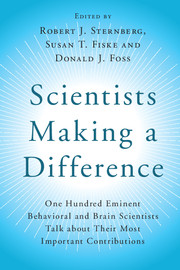 Scientists Making a Difference
Scientists Making a Difference from Section B - Learning and Memory
Published online by Cambridge University Press: 05 August 2016
It is hard to imagine how understanding memory could not be important for the field and for humanity generally: Memory is what we are, and what defines us as individuals. Despite an ever-increasing reliance on external aids to memory (e.g., looking up forgotten material on the web), we rely on our memory for almost all decisions and interactions in our daily lives. Everyone is particularly aware of the tragedy of memory failure due to diseases such as Alzheimer's. With memory so fundamental, with such a broad scope, and with such great complexity, it is essential that its components be delineated carefully, and it helps enormously if such delineation is made precise with the use of formal theorizing and especially quantitative modeling.
Such delineation was what we put forth in our 1968 chapter, and is the primary reason we regard it as our most important contribution, despite its age and the fact that one of us was a graduate student at the time of its publication. This chapter has served as a template and inspiration for about fifty years of research since.
Our theory has been called the “modal model” of memory and it remains so: Almost all of its insights into memory can be found in contemporary publications. It represented a turning point in the evolution of memory theory because it took many of the concepts proposed since the field of psychology began, as exemplified by William James in his 1890 book Principles of Psychology, and formalized them in a comprehensive framework that was backed up by empirical research (much of it original) and quantitative modeling. The theory has undergone many elaborations over the years, in our hands and those of students and colleagues, and has served as a starting point for the development of alternative models, though most of them instantiated the same basic concepts in alternative verbal and computational machinery.
What are these core concepts? We divided the concepts into structural components of the memory system and processes that controlled memory storage and retrieval. It was primarily the second of these that led us to the theory's formulation and its general acceptance: It seemed obvious to us that the control of memorial processes such as storage, retrieval, and decision was responsible for much of the observed phenomena of memory, and such control processes were in need of exposition, delineation, and formal modeling.
To save this book to your Kindle, first ensure [email protected] is added to your Approved Personal Document E-mail List under your Personal Document Settings on the Manage Your Content and Devices page of your Amazon account. Then enter the ‘name’ part of your Kindle email address below. Find out more about saving to your Kindle.
Note you can select to save to either the @free.kindle.com or @kindle.com variations. ‘@free.kindle.com’ emails are free but can only be saved to your device when it is connected to wi-fi. ‘@kindle.com’ emails can be delivered even when you are not connected to wi-fi, but note that service fees apply.
Find out more about the Kindle Personal Document Service.
To save content items to your account, please confirm that you agree to abide by our usage policies. If this is the first time you use this feature, you will be asked to authorise Cambridge Core to connect with your account. Find out more about saving content to Dropbox.
To save content items to your account, please confirm that you agree to abide by our usage policies. If this is the first time you use this feature, you will be asked to authorise Cambridge Core to connect with your account. Find out more about saving content to Google Drive.